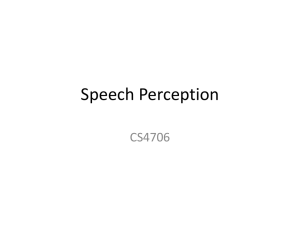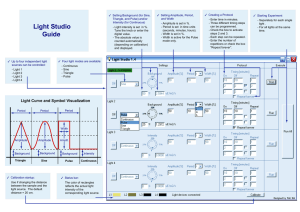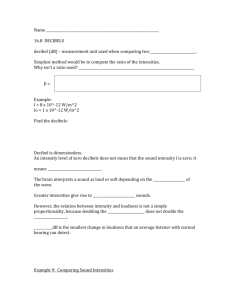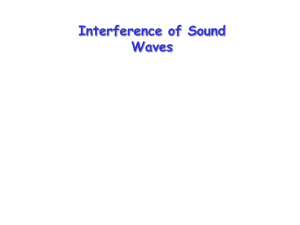Lecture 1-2: Sound Pressure Level Scale
advertisement
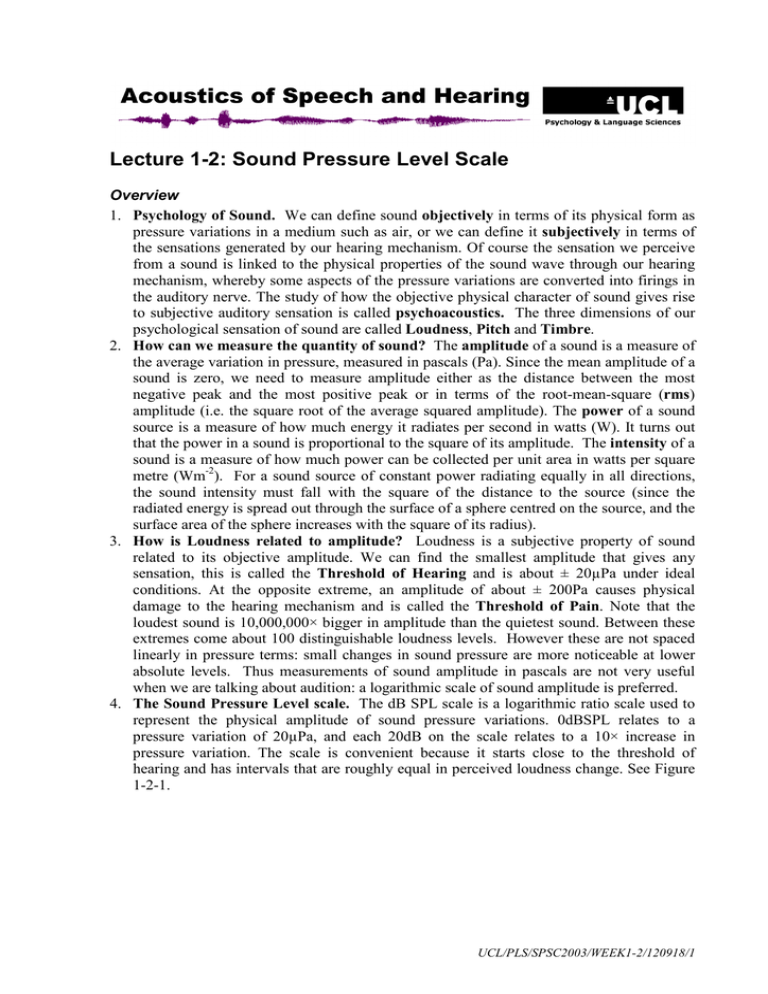
Lecture 1-2: Sound Pressure Level Scale Overview 1. Psychology of Sound. We can define sound objectively in terms of its physical form as pressure variations in a medium such as air, or we can define it subjectively in terms of the sensations generated by our hearing mechanism. Of course the sensation we perceive from a sound is linked to the physical properties of the sound wave through our hearing mechanism, whereby some aspects of the pressure variations are converted into firings in the auditory nerve. The study of how the objective physical character of sound gives rise to subjective auditory sensation is called psychoacoustics. The three dimensions of our psychological sensation of sound are called Loudness, Pitch and Timbre. 2. How can we measure the quantity of sound? The amplitude of a sound is a measure of the average variation in pressure, measured in pascals (Pa). Since the mean amplitude of a sound is zero, we need to measure amplitude either as the distance between the most negative peak and the most positive peak or in terms of the root-mean-square (rms) amplitude (i.e. the square root of the average squared amplitude). The power of a sound source is a measure of how much energy it radiates per second in watts (W). It turns out that the power in a sound is proportional to the square of its amplitude. The intensity of a sound is a measure of how much power can be collected per unit area in watts per square metre (Wm-2). For a sound source of constant power radiating equally in all directions, the sound intensity must fall with the square of the distance to the source (since the radiated energy is spread out through the surface of a sphere centred on the source, and the surface area of the sphere increases with the square of its radius). 3. How is Loudness related to amplitude? Loudness is a subjective property of sound related to its objective amplitude. We can find the smallest amplitude that gives any sensation, this is called the Threshold of Hearing and is about ± 20µPa under ideal conditions. At the opposite extreme, an amplitude of about ± 200Pa causes physical damage to the hearing mechanism and is called the Threshold of Pain. Note that the loudest sound is 10,000,000× bigger in amplitude than the quietest sound. Between these extremes come about 100 distinguishable loudness levels. However these are not spaced linearly in pressure terms: small changes in sound pressure are more noticeable at lower absolute levels. Thus measurements of sound amplitude in pascals are not very useful when we are talking about audition: a logarithmic scale of sound amplitude is preferred. 4. The Sound Pressure Level scale. The dB SPL scale is a logarithmic ratio scale used to represent the physical amplitude of sound pressure variations. 0dBSPL relates to a pressure variation of 20µPa, and each 20dB on the scale relates to a 10× increase in pressure variation. The scale is convenient because it starts close to the threshold of hearing and has intervals that are roughly equal in perceived loudness change. See Figure 1-2-1. UCL/PLS/SPSC2003/WEEK1-2/120918/1 Reading Essential: Discussion of logarithms in "Introduction to Acoustics" Choose at least one from: Rosen & Howell, Signals and Systems for Speech and Hearing (1st edition), Amplitude measurements pp29-40. Essential basics of decibels. Speaks, Introduction to Sound (3rd edition), Chapter 4: Sound Intensity and Sound Pressure: the Decibel. Thorough but mathematical. Web: Interactive tutorial on logarithms: http://www.phon.ucl.ac.uk/cgi-bin/wtutor?tutorial=t-log Introduction to the Decibel Scale Pressure Ratio Standard Form 0.0000001 0.000001 0.00001 0.0001 0.001 0.01 0.1 1.0 10.0 100.0 1000.0 10000.0 100000.0 1000000.0 10000000.0 10-7 10-6 10-5 10-4 10-3 10-2 10-1 100 101 102 103 104 105 106 107 Power of 10 =log10(ratio) -7 -6 -5 -4 -3 -2 -1 0 1 2 3 4 5 6 7 Decibels (dB) -140 -120 -100 -80 -60 -40 -20 0 20 40 60 80 100 120 140 measured pressure Calculating decibels: 20 log10 reference pressure Easy to remember: ×1 = +0dB ×2 = +6dB ×10 = +20dB Reasons for Using the dB SPL Scale 1. More easily handle range of pressures from very large to very small 2. Easier calculations (e.g. amplification=addition, attenuation=subtraction) 3. Internationally recognised standard measure 4. Zero point on scale is human threshold 5. Closer to the way we perceive changes in sound pressure. UCL/PLS/SPSC2003/WEEK1-2/120918/2 Sound Pressure Level Quiz 1) 0 dB SPL means: a) there is no sound b) the measured pressure = 20µPa c) the sound is barely audible 2) An amplification system doubles the amplitude of sounds passing through it. What is the dB SPL value of a sound of 60 dB SPL after it has passed through the system? a) 62 dB SPL b) 66 dB SPL c) 120 dB SPL 3) An attenuator reduces the amplitude of a sound by a factor 10. What is the dB SPL value of a sound at 0 dB SPL after it has passed through the attenuator? 4) A hearing aid increases the amplitude of sounds by a factor of 1000. What is its gain in decibels? 5) What's wrong with the statement: "The loudness of the sound was 78dB SPL"? Learning Activities You can help yourself understand and remember this week’s teaching by doing the following activities before next week: 1. Write a paragraph on the relationship between physical pressure variations and subjective sound sensation. Be sure to discuss the range of typical pressure variations recognisable as sound and the difference between the loudness and the intensity of a sound. 2. Explain in your own words what is meant by the amplitude, power and intensity of a sound. 3. Write a definition of the decibel scale and list some reasons why the decibel scale is particularly useful for measuring the intensity of sound. 4. Practice converting sound pressures in Pa to dBSPL and find out how to do this calculation in reverse. If you are unsure about any of these, make sure you ask questions in the lab or in tutorial. Reflections You can improve your learning by reflecting on your understanding. Here are some suggestions for questions related to this week’s teaching. 1. What is the difference between the loudness and the intensity of a sound? 2. What is meant by the logarithm of a number? 3. What are the characteristics of a logarithmic scale? 4. What is a decibel? 5. How can a pressure variation of known size be expressed in dBSPL? 6. Why doesn't 0dB mean that nothing is measured? 7. How do we convert decibel values on the SPL scale back to pressure? 8. How do loud sounds damage your hearing? 9. How does a hearing aid affect your threshold of hearing? 10. Why does a sound get quieter the further away you are from its source? UCL/PLS/SPSC2003/WEEK1-2/120918/3 Figure 1-2-1 The Sound Pressure Level Scale UCL/PLS/SPSC2003/WEEK1-2/120918/4 Lab 1-2: The Sound Pressure Level Scale Introduction The sensation of loudness is not linearly related to the physical intensity of sound. Instead the relationship takes a more logarithmic form, with equal increasing steps of loudness being roughly equivalent to increasing multiples of intensity. We use a decibel scale referenced to the threshold of human hearing (the dBSPL scale) to create a physical scale of intensity more closely related to human hearing. As sound spreads out from a source its energy must become more thinly distributed throughout a larger volume of air and so its intensity falls with increasing distance to the source. The change in intensity with distance should be predictable if the sound path is not obstructed. In this laboratory you will build a simple meter for measuring the intensity of sounds. You will measure the intensity of some common sounds and see how the intensity of sounds diminishes with distance. Scientific Objectives • to measure how the intensity of sounds diminishes with distance and to understand the influence of room acoustics on this effect. Learning Objectives • to understand how to build a sound level meter calibrated in standard units (dBSPL) • to gain an appreciation of the loudness of sounds at various physical intensities. Apparatus You are provided with a piezo-electric microphone element and a battery-powered voltmeter. Various noises will be generated in the laboratory and calibrated measurements of intensity will be made using a commercial sound-level meter. The voltmeter has a wide range of sensitivity from 1mV (1/1000 of a volt) across its scale to 1V across its scale. You will need to use the control which sets the full scale voltage. Note that the control has settings of 1mV, 3mV, 10mV, 30mV, 100mV, 300mV and 1V. You should read the meter according to the current sensitivity setting. Calibration - Method Work in pairs: one to hold the microphone (by the cable, near the element) and one to read the voltmeter and write down readings. You will be positioned close to a loudspeaker which will play noise in steps of increasing intensity, but of roughly equal changes in loudness. At each step you will be able to record the voltage reading of your voltmeter and the sound-level from the sound-level meter. Calibration - Observations Set out your observations in a table with the following headings: (a) Sound Level (dBSPL), (b) Voltage (mV), (c) Voltage Ratio to 0.1mV (i.e. the value in (b) divided by 0.1mV), (d) Voltage Ratio (dB) (i.e. 20 x log10(value in (c))). Comment on the accuracy of your measurements. UCL/PLS/SPSC2003/WEEK1-2/120918/5 Plot a calibration graph of Voltage Ratio (dB) against Sound-Level (dBSPL). Plot the Sound Level along the x-axis from 50 to 110dBSPL. Comment on the shape of your graph. Distance Measurements - Method A standard intensity noise will be produced from a speaker at one end of the laboratory. Record, using your voltmeter, the voltage produced by the microphone at distances of 0.5m, 1m, 2m, 4m, 6m, 8m and 10m from the loudspeaker. Distance Measurements - Observations Set out your observations in a table with the following headings: (a) Distance to loudspeaker (m), (b) Voltage (mV), (c) Voltage ratio to 0.1mV (i.e. the value in (b) divided by 0.1mV), (d) Voltage ratio (dB) (i.e. 20 x log10(value in (c))). (e) Sound-Level (dBSPL) (found from calibration graph using (d)) Comment on the accuracy of your measurements. Plot a graph of Sound-Level (dBSPL) against logarithmic distance from the loudspeaker (m). Comment on the shape of the graph. Other Observations Find some other noises to measure, for example: simple vowels and fricatives at conversational distances, or the sound-level coming from your music player's headphones. Convert your voltage readings to dBSPL. At a distance of 1m, what dBSPL value would you consider "quiet talking"? What level would you consider "loud talking"? Concluding Remarks What shape would you expect for the graph of intensity against distance? Why instead does the graph of intensity against distance flatten out? Think of an experiment in which you might obtain a graph of loudness against dBSPL. Report guidelines First write an Introduction which discusses what is meant by the intensity and the loudness of sounds. Introduce the dBSPL scale and state the aims of the experiment. You only need to describe the equipment and methodology very briefly. Then write a section called Results and Discussion which describes and displays the measurements you have made. Use the lab sheet for ideas about topics to discuss for each set of measurements. Finally you should draw some conclusions about what the experiment has shown. Use the Concluding Remarks section to give you some ideas about what to discuss. An example lab report showing the size, format and writing style can be downloaded from the course web site. UCL/PLS/SPSC2003/WEEK1-2/120918/6


